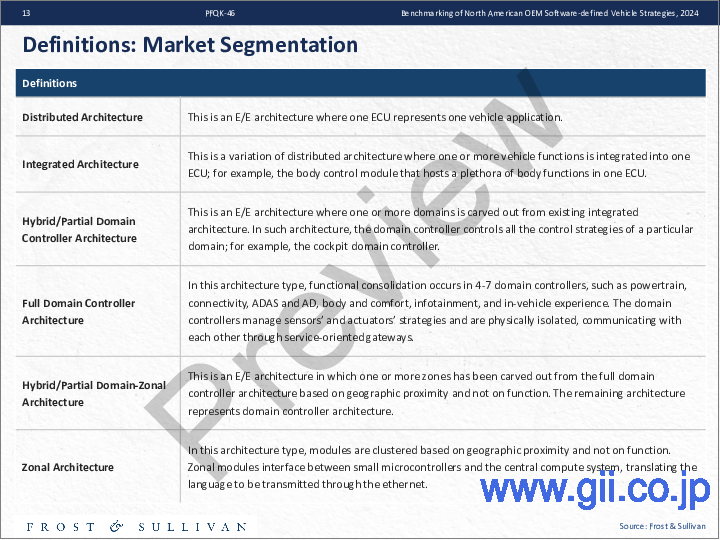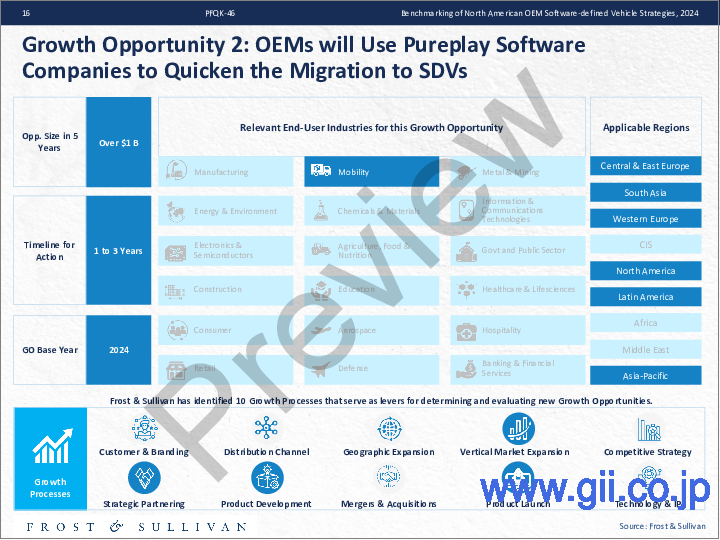|
|
市場調査レポート
商品コード
1578345
北米のOEMソフトウエア定義車両戦略のベンチマーク、2024年Benchmarking of North American OEM Software-defined Vehicle Strategies, 2024 |
||||||
|
|||||||
| 北米のOEMソフトウエア定義車両戦略のベンチマーク、2024年 |
|
出版日: 2024年09月25日
発行: Frost & Sullivan
ページ情報: 英文 53 Pages
納期: 即日から翌営業日
|
全表示
- 概要
- 目次
北米OEMは反復可能な収益手段への移行の最前線にあり、将来の成長はデータ収益化戦略を利用した革新的なビジネスモデルにかかっています。
相手先商標製品メーカー(OEM)は、かつては機械的な機能で製品を差別化していました。今日、消費者は運転支援、コネクティビティ、快適な利便性サービスなど、ソフトウェアで定義された機能をますます求めるようになっています。電動化、自律走行、シェアードモビリティ、コネクティビティなどの技術の融合により、OEMは従来のハードポイント定義のアーキテクチャからソフトウェア指向のアーキテクチャに移行しつつあります。その一方で、こうした動向は顧客の期待を再構築し、OEMは新世代の自動車でそれらに対応することを余儀なくされ、自動車は車輪の上のソフトウェアと化しています。
携帯電話業界と同様に、自動車業界も再生を経験しており、周期的に収益を上げる従来のビジネスモデルは、自動車のライフサイクルを通じて継続的にキャッシュフローを生み出すという課題に直面しています。自動車業界は、ハードウェアからソフトウェアへのアプローチに移行しつつあります。自動車はますます複雑化し、ソフトウェアコードの行数は以前よりも増えています。
ソフトウェアで定義された車両(SDV)のコンセプトが支持を集め、製品や機能の開発哲学に影響を与えています。SDVは、新しい安全性、快適性、利便性を提供するだけでなく、ハードウェアで定義されたものよりも多くの利点を提供します。SDVは、ファームウェアのパッチ、改良を受けるためのインフォテインメント、パワートレインや車両ダイナミクスなどのコア機能のモニタリングとチューニング、機能オンデマンドの快適性・利便性サービスなどをカバーするOTA(Over-the-Air)アップデートを顧客に提供します。これにより、OEMは、オンデマンドの機能サービスから収益を得ながら、ライフサイクルを通じて車両の改良とアップグレードを行うことができ、顧客とのより深く結びついた関係を築くことができます。
SDVはまた、自動車業界における記念碑的な変化の最前線にあり、自動車の設計と開発の方法を変えつつあります。アーキテクチャの変化は明らかで、OEMは従来のプラットフォームアーキテクチャよりも新しいアーキテクチャを好んでいます。
この調査サービスでは、北米OEM 3社のSDV戦略をベンチマークしています。これらの動向がFord、GM、Teslaに与える影響について論じています。また、SDV領域におけるOEMやサプライヤーを取り巻くエコシステムについても分析しています。
目次
成長環境
- 主な調査結果
- OEM比較分析:ハードウェア戦略
- OEMの比較分析ソフトウェア戦略
- OEMの比較分析SDV戦略と実装
ソフトウエア定義車両セクターにおける変革
- なぜ成長が難しくなっているのか?
- The Strategic Imperative 8(TM)
- 北米のOEMソフトウェア定義の自動車のベンチマーキングにおける上位3つの戦略的重要事項の影響
エコシステム
- 調査サービス範囲
- 成長促進要因
- 成長抑制要因
- 定義市場セグメンテーション
- 主な競合企業
北米のOEMソフトウエア定義車両戦略:Ford
- Fordのハードウェア戦略
- Fordの新アーキテクチャ搭載車種の可能性リスト
- Fordのソフトウェア開発戦略
- Fordのソフトウェア戦略Model e(TM)ビジネスユニット
- Fordの注力分野、SDVエコシステム、戦略
北米のOEMソフトウエア定義車両戦略:GM
- GMのハードウェア戦略:車両インテリジェンス・プラットフォーム
- 車両インテリジェンス・プラットフォームの展開
- GMのソフトウェア開発戦略
- GMのソフトウェア戦略 Ultifiソフトウェアプラットフォーム
- GMの注力分野、SDVエコシステム、戦略
北米のOEMソフトウエア定義車両戦略:Tesla
- Teslaのハードウェア戦略
- 新アーキテクチャでのTeslaモデル候補リスト
- Teslaのソフトウェア開発戦略
- Teslaのソフトウェア戦略ソフトウェアプラットフォーム
- Teslaの注力分野、SDVエコシステム、戦略
成長機会ユニバース
- 成長機会1:SDVは機能仮想化とクラウドコンピューティングの機会を開く
- 成長機会2:OEMは、Pureplayソフトウェア会社を利用してSDVへの移行を迅速化する
- 成長機会3:IT企業は自動車メーカーの技術ノウハウ開発を支援する
ベストプラクティスの認識
フロストレーダー
次のステップ
- 成長機会のメリットと影響
- 次のステップ
- 図表一覧
- 免責事項
North American OEMs have been at the Forefront of the Transition to Repeatable Avenues of Revenue, and Future Growth Hinges on Innovative Business Models that Use Data Monetization Strategies
Original equipment manufacturers (OEMs) used to differentiate their products based on mechanical features. Today, consumers are increasingly looking for software-defined features, such as driver assistance, connectivity, and comfort-convenience services. The convergence of technologies, including electrification, autonomous driving, shared mobility, and connectivity, is causing OEMs to migrate from traditional hardpoint-defined architecture to software-oriented architecture. Meanwhile, these trends are reshaping customer expectations and forcing OEMs to address them in new-generation vehicles, turning vehicles into software on wheels.
Similar to the mobile phone industry, the automotive industry is experiencing a rebirth, and traditional business models of cyclical revenue generation are challenged by continuous cash flow generation throughout the vehicle life cycle. The automotive industry is transitioning from a hardware to a software approach to building vehicles. Vehicles are increasingly complex, with more lines of software code than in previous years.
The software-defined vehicle (SDV) concept has gained traction, impacting product and feature development philosophies. Beyond unlocking new safety, comfort, and convenience features, SDVs offer more advantages than their hardware-defined counterparts. SDVs allow customers over-the-air (OTA) updates that cover firmware patches, infotainment to receive improvements, monitoring and tuning of core functional capabilities, such as powertrain and vehicle dynamics, and feature-on-demand comfort-convenience services. This allows OEMs to improve and upgrade vehicles on the go throughout their life cycle while generating revenue from feature-on-demand services, culminating in deeper, more connected relationships with customers.
SDVs are also at the forefront of monumental changes in the automotive industry; they are changing the way vehicles are designed and developed. Changes in architecture are evident, with OEMs preferring new architecture over traditional platform architecture.
This research service benchmarks 3 North American OEMs' SDV strategies. It discusses the impact of these trends on Ford, GM, and Tesla. The analysis also covers the ecosystem surrounding the OEMs and suppliers in the SDV space.
Table of Contents
Growth Environment
- Key Findings
- OEM Comparative Analysis: Hardware Strategy
- OEM Comparative Analysis: Software Strategy
- OEM Comparative Analysis: SDV Strategy and Implementation
Transformation in the Software-defined Vehicles Sector
- Why is it Increasingly Difficult to Grow?
- The Strategic Imperative 8™
- The Impact of the Top 3 Strategic Imperatives on the Benchmarking of North American OEM Software-defined Vehicle Strategies
Ecosystem
- Research Service Scope
- Growth Drivers
- Growth Restraints
- Definitions: Market Segmentation
- Key Competitors
North American OEM Software-defined Vehicle Strategy: Ford
- Ford's Hardware Strategy
- Potential List of Ford Models on New Architecture
- Ford's Software Development Strategy
- Ford's Software Strategy: Model e™ Business Unit
- Ford's Focus Areas, SDV Ecosystem, and Strategy
North American OEM Software-defined Vehicle Strategy: GM
- GM's Hardware Strategy: Vehicle Intelligence Platform
- Vehicle Intelligence Platform Deployment
- GM's Software Development Strategy
- GM's Software Strategy: Ultifi Software Platform
- GM's Focus Areas, SDV Ecosystem, and Strategy
North American OEM Software-defined Vehicle Strategy: Tesla
- Tesla's Hardware Strategy
- Potential List of Tesla Models on New Architecture
- Tesla's Software Development Strategy
- Tesla's Software Strategy: Software Platform
- Tesla's Focus Areas, SDV Ecosystem, and Strategy
Growth Opportunity Universe
- Growth Opportunity 1: SDVs will Open Opportunities in Functional Virtualization and Cloud Computing
- Growth Opportunity 2: OEMs will Use Pureplay Software Companies to Quicken the Migration to SDVs
- Growth Opportunity 3: IT Companies will Help Automakers Develop Technology know-how
Best Practices Recognition
- Best Practices Recognition
Frost Radar
- Frost Radar
Next Steps
- Benefits and Impacts of Growth Opportunities
- Next Steps
- List of Exhibits
- Legal Disclaimer





